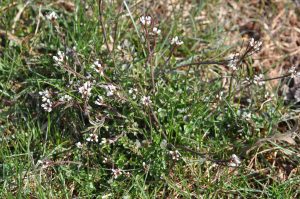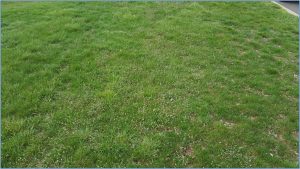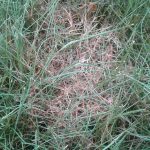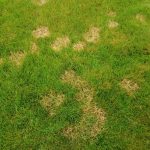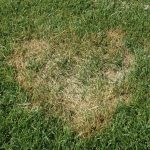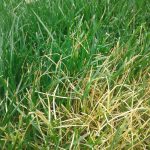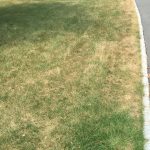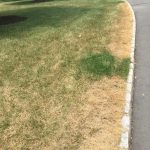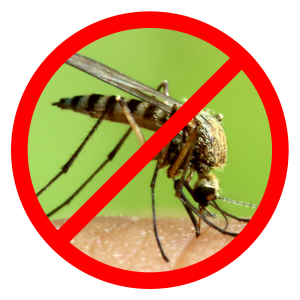Category Archives: Uncategorized
Dollar Spot Disease
Summer weather provides a host of environmental stresses to the cool-season turf varieties that we have in New Jersey. Temperature, humidity, lack of rain, and sometimes too much rain all impact residential lawns throughout the summer months. Outside of heat stress, foliar diseases are a common issue we encounter as lawn care professionals. One of the most frequent diseases we see in the summer months is Dollar Spot.
Appearance
As I mentioned briefly, Dollar Spot is a foliar disease affecting the leaf tissue of grass blades. You can imagine because of the name; the most notable trait of this disease is its appearance. In the image below, the disease presents as burned or bleached circles in the lawn that resemble silver dollars. These circle-like shapes can continue to grow and morph into bigger areas that then no longer resemble small circles.
Causes of the Disease
If this disease is so common, what is the reason it is in your lawn? Well, unfortunately for the homeowner, certain grass varieties are more susceptible to this disease. We commonly find dollar spot on fine fescues, especially when these shade loving varieties are planted directly in the sun. Using generic sun and shade mixes when homeowners seed is usually the main culprit of having turf that prefers the shade growing in the full sun. Other varieties like rye grass, blue grass, and even tall fescue are also susceptible.
Secondly, weather conditions also play a large part of when this disease becomes active. Most foliar diseases we encounter in the summer months like hot, humid, and wet weather. This means, nighttime temperatures above 55 and daytime temperatures in the 80’s-90’s. The main component however is moisture, the turf blades must be wet for dollar spot to infect the plant. Some recent summers in New Jersey, we have experienced a great increase in rainfall, while others are more notably remembered for a drought.
The moisture component is not just left to mother nature, we can be promoting disease by watering too frequently. Remember, the grass blades must be wet for the disease to infect the plant, so having your sprinkler set to water every day increases the likelihood of disease. Long periods of leaf wetness from dew, rain, or sprinkler irrigation, coupled with warm temperatures, leads to the perfect environment for dollar spot to start spreading. We will discuss proper watering a little later in this blog.
What do you do once your lawn has dollar spot disease? There are two areas of control that we should discuss: chemical and cultural.
Dollar Spot Treatment
From the chemical side of things, you can apply a foliar fungicide to your lawn to help stop the spread of the disease for 20-28 days. With the appropriate use of fertilizer and irrigation, you can start to grow out the turf and you will see the diseased tissue going away with mowing. Something very important to remember, a fungicide applied to the lawn after the disease is present will NOT make the disease go away. The fungicide only stops the spread of the disease for a period of about a month. An additional fungicide may need to be applied if favorable weather conditions continue.
If you are reading this blog because you have dollar spot disease in your lawn every summer, then a preventable fungicide program may be the solution you are looking for. If you apply a foliar fungicide to the lawn before the disease is active, you can prevent disease activity on the property for about a month. Talk to your lawn care professional to see if you should be applying fungicides preventatively, and depending on your property, what months they recommend. For people in our service area, we normally recommend a monthly fungicide applied from June through August.
Cultural Considerations
We touched on how most diseases need the presence of prolonged wet foliage. For homeowners that have irrigation or hose-end sprinklers; there is a way to reduce the amount of time your grass blades stay wet. Changing your watering schedule from running your sprinklers every day for twenty minutes, to DEEP and INFREQUENT watering. This means only water every third or fourth day for an hour to an hour and a half per zone. The goal is to provide your lawn with an inch of water every week while letting the grass blades dry out in between watering. The best time to water is between midnight and 6am, this is because the grass is already wet from dew formation so we are not prolonging the time it stays wet. For more information about a watering schedule, please visit our blog.
Additionally, we would also recommend adding aeration to your lawn care maintenance schedule at least every other year. Decreasing soil compaction and thatch improves water and nutrient flow deeper into the soil which leads to root growth. Healthier grass plants = more stress tolerant.
- What the lawn looks like after core aeration.
Finally, if your property is largely a grass variety that is more susceptible to Dollar Spot disease, you can overseed your lawn annually with a more tolerant grass type. We would recommend using the right variety for the area you plan on seeding. We like turf type tall fescue, Kentucky bluegrass and annual ryegrass in areas that get a lot of sun and fine fescues in areas that are shaded. If you plan to go down the route of overseeding your lawn and you are in our service area, feel free to reach out to our office and we can help answer any questions.
Conclusion
Dollar Spot disease is a common disease in the New Jersey area during the summer months. While it is common, there are a couple of steps you can take to reduce the damage of the disease both culturally through your watering methods, and chemically with fungicides and adequate fertilization.
If you have questions about Dollar Spot disease, feel free to reach out to our office to speak with a lawn care professional, at 908-281-7888.
Hairy Bittercress: The Winter Invader
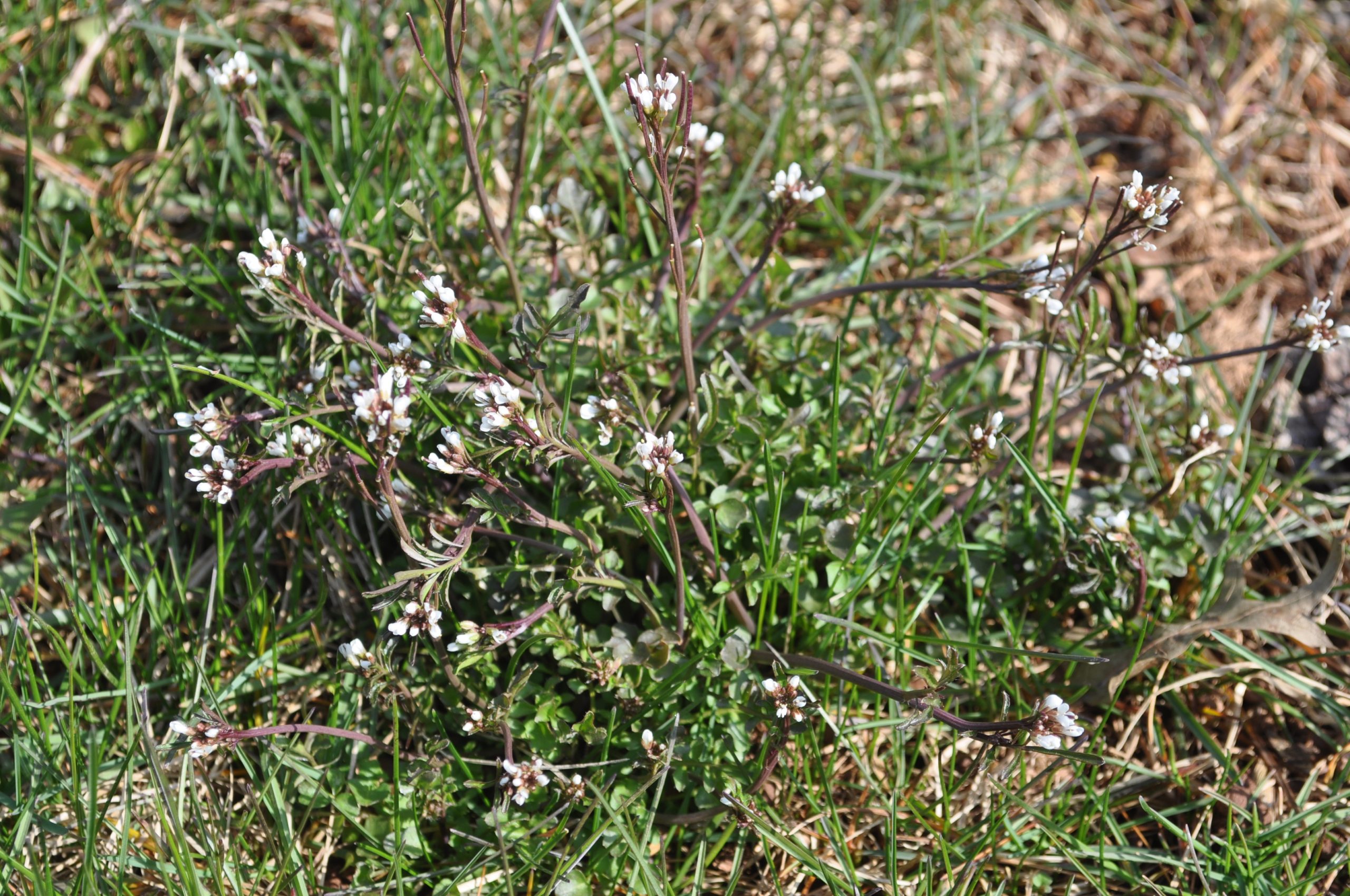
With over 30 years of experience in lawn care, I can say without question the most common misconception is that broadleaf weeds are preventable. There is nothing that makes customers more frustrated than seeing broadleaf weeds in a lawn they are paying to have maintained. So why do broadleaf weeds pop up in maintained lawns from time to time?
The Grand Illusion
If you search the internet, you may find a few products labeled for preventatively controlling broadleaf weeds. However, these products are not practical for residential lawn use, and are generally not included as part of any normal maintenance program. Instead, maintenance programs typically utilize control products that are applied to the foliage and stems of existing broadleaf weeds which the plants absorb into their roots. When done often enough in combination with regular fertilization, the combined regimen will discourage broadleaf weed growth while promoting the dense growth of desirable turf grasses. Because the weeds are almost never allowed to outgrow the grass, it appears to the homeowner as though the weeds are being prevented.
Hairy Bittercress
In the early part of each spring, customers call in waves about a weed with little white flowers popping up all over the lawn. Comments about how they’ve “never seen this weed before”, or that it “wasn’t there last year” are common. So why is this particular weed such an issue each spring worth writing about? To answer that question, we need to rewind a bit.
Hairy bittercress is a winter annual that starts growing in fall as a small, low-growing weed. The plant develops as a basal rosette (like the dandelion), with leaves that are round to kidney shaped, the largest of which can be found at the end of the stems. The plants remain smaller at this phase and are only slightly more obvious when they occur in mulch beds or any place where grass is not present. As more bittercress continues to germinate into November, regular weed control treatments stop. In addition, the grass starts to slip into winter dormancy which slows stem and leaf growth dramatically.
With the grass dormant for the winter, and no winter weed control applications taking place, the hairy bittercress continues to mature off and on through the colder weather. If the winter is snow covered for extensive periods, the maturation of this weed is very slow. Years with winters like this are when homeowners are less likely to take note of this weed in their lawns, because it does not have the opportunity to bloom before their initial weed control treatments are applied. However, in years where the winter is not as cold and there is almost no snow/ice cover, the hairy bittercress matures quickly and goes into bloom much sooner than initial treatments can be applied and well before any lawn mower is even pulled out of its shed. The white flowers sprout atop 3-9” stems and any homeowner can spot this winter invader with just a brief observation being made of the lawn from their front door.
What to do?
First, don’t panic. Second, call your lawn care provider and explain that there is hairy bittercress growing in the lawn. They will send out a technician to provide your initial treatment of the spring, which should include broadleaf weed control. For all of the concern raised by the presence of this pest, it is actually very easy to control with a single application of broadleaf weed control.
Hairy bittercress plants can be easily plucked from the lawn from the base of the stem if herbicide use is not desired. It is an annual, so any plants missed will die as it gets warmer; however, if pulling weeds, homeowners should try to get as many as possible before plants go into seed. Hairy bittercress develops very obvious seed pods that form upright along stems. They will actually burst when disturbed and catapult seeds as far as 16 feet! The more plants removed before these structures form, the better.
Conclusion
The best defense against any weed is maintaining a thick, healthy lawn. Seeding whenever necessary to establish dense turf cover will keep weeds from being able to infiltrate the lawn. Proper fertilizer applications done regularly throughout the year should also help to promote desirable turf growth which will further crowd out unwanted weeds.
If you have any questions about hairy bittercress and controlling it, please give our office a call at 908-281-7888 or request a free estimate online.
Improper Watering Promotes Disease
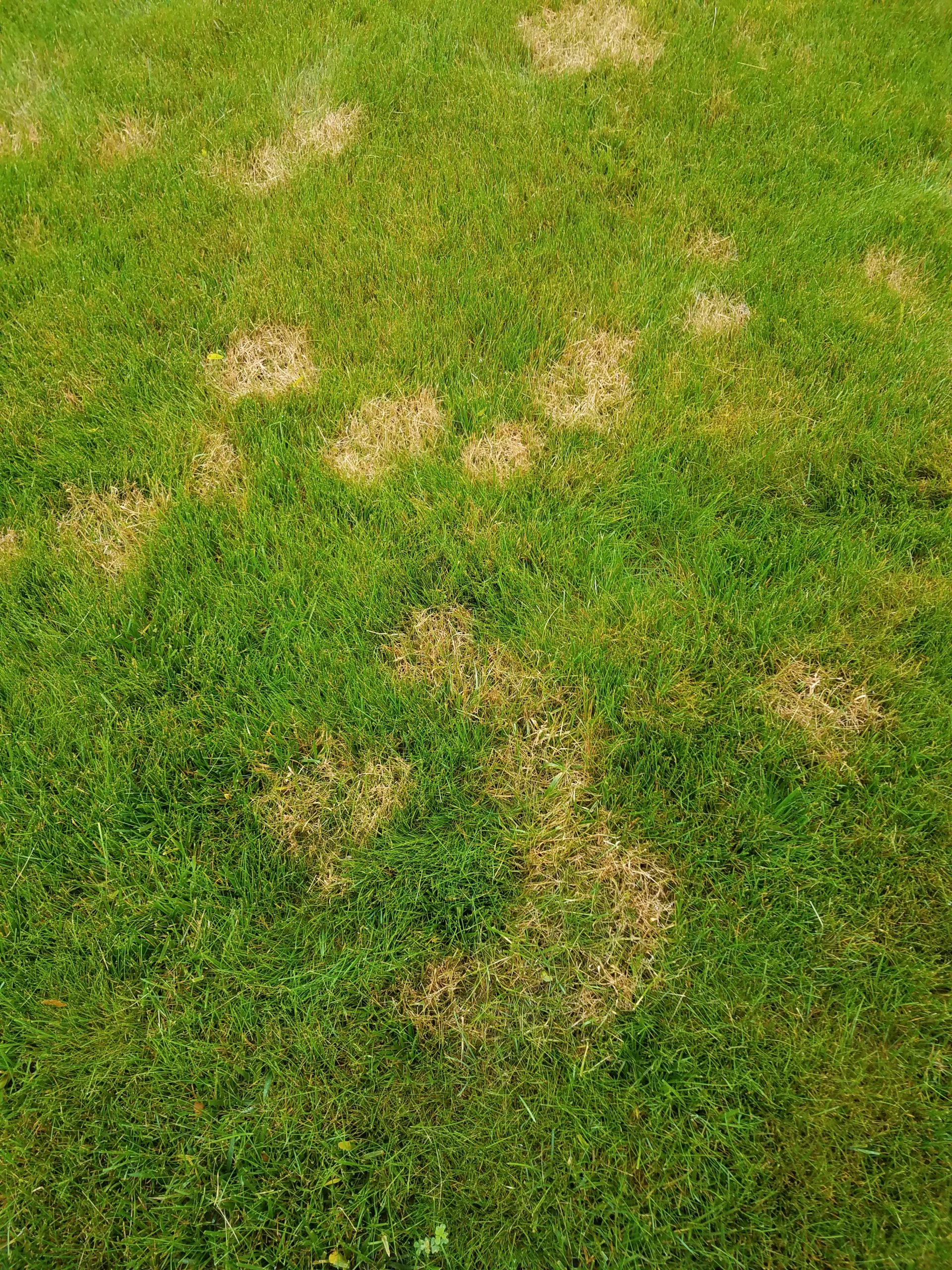
Watering your lawn is one of the best things you can do during the summer months to keep it looking great. Unfortunately, many people don’t know that irrigating incorrectly can have negative effects on your turf’s appearance. Improper watering practices can play a major role when it comes to lawn diseases. This blog discusses proper watering practices to limit disease problems in your lawn.
When visiting a homeowner’s property, I commonly see irrigation systems set to run a watering cycle every day or every other day for twenty minutes. Unfortunately, this watering schedule is not ideal for promoting turf health.
Watering every day or every other day for twenty minutes only keeps the surface of the grass and the top one to two inches of soil wet. This can cause a number of issues. First, when watering every day for a short amount of time the surface of the grass does not get a chance to dry out, which increases the likelihood of getting disease, especially in the summer. It also promotes a shallow root system since the moisture doesn’t penetrate the soil very deep. Turf with shallow roots will not be as healthy or resilient as a plant with a deep, extensive root system. In addition, our service area is predominantly clay-based soil, which holds moisture much longer than other soils. Finally, frequent watering leads to clogged pours and oxygen not being able to get to the root system of the plant, weakening and potentially killing the plant.
How should I run my sprinklers?
We recommend watering infrequently, but for a long duration so the turf and top layer of soil has time to dry out in between watering sessions and help curb disease activity. This also allows the water to penetrate deep into the soil, promoting a deep root system. A good starting point for an irrigation system is twice per week and one hour per zone. This is just a starting point, you’ll need to adjust this for your particular property, especially if your lawn holds moisture in certain areas or has a history of getting disease. You may also need to stop irrigating if we get a lot of rain in a short period of time. One thing to keep in mind during the summer is the longer the grass blades stay wet, the better the chance of getting turf disease.
Almost all the same principles can be applied to homeowners that need to water using a hose-end sprinkler. The biggest difference being the running time. The output of the hose will be much less than an irrigation system which will increase the time you need to water your lawn. The time will most likely be 2-3 hours per area of coverage. Again, check your soil moisture to make sure the water is getting deep enough.
When is the best time of day to run sprinklers?
We often see irrigation systems set to run early in the evening. When it comes to preventing disease, running sprinklers at this time is a bad idea. We want to limit how long the grass blades remain wet. If you start watering your lawn at 6 pm, the turf is going to stay wet through the night until the sun comes up the next day. The grass will be wet for over 12 hours, which is not ideal.
The best time to water is from 12 am to 6 am. The reason for this time frame, is because the lawn gets a natural dew overnight, and there is nothing we can do to stop that. Since the grass is already going to be wet during this time naturally, it’s best to also water at the same time.
Start Watering Before the Lawn Becomes Stressed
Many homeowners wait until the lawn starts to look heat stressed before watering. Unfortunately, this mistake can lead to disease infection. The reason being that heat stressed lawns are more vulnerable to disease outbreak. Just like people, the healthier they are, the more likely they can fight off infection. Start to run your irrigation in late spring before it becomes heat stressed.
Over Watering Turf
This isn’t something I run into too often, but I have seen a few instances where over watering creates large issues. Irrigating turf every day or every other day for 45 minutes to an hour is going to create problems. First your watering bill is going to be through the roof when it doesn’t need to be. The pours at the surface of the soil are never going to dry out and will keep your lawn waterlogged. When this happens, it creates a nice breeding ground for gray leaf spot. This is not a disease you want in your lawn, as it spreads very quick and does a good amount of damage that would require seeding. All the lawn needs is a heavy watering once maybe twice a week depending on weather conditions for 60 to 90 minutes per zone with an irrigation system, and around 2-3 hours with a hose-end sprinkler.
In conclusion
To recap, water on an as needed basis. The three key points you should follow are; avoid watering every day or every other day, water heavily to get the water down at least six inches into the soil and avoid prolonged wetness of the surface by watering at the proper time of day. By following these cultural practices, you will help the turf by limiting the spread of disease. The worst part about lawn disease is you could do everything perfectly and still get disease. Just like people, turf is a living thing and can get sick. If this is the case, there are fungicide treatments that can be applied to prevent and stop the spread of most diseases.
For more information about best watering practices or disease control, feel free to call our office and request a free estimate.






